Top Customer Pain Points Examples and Effective Solutions
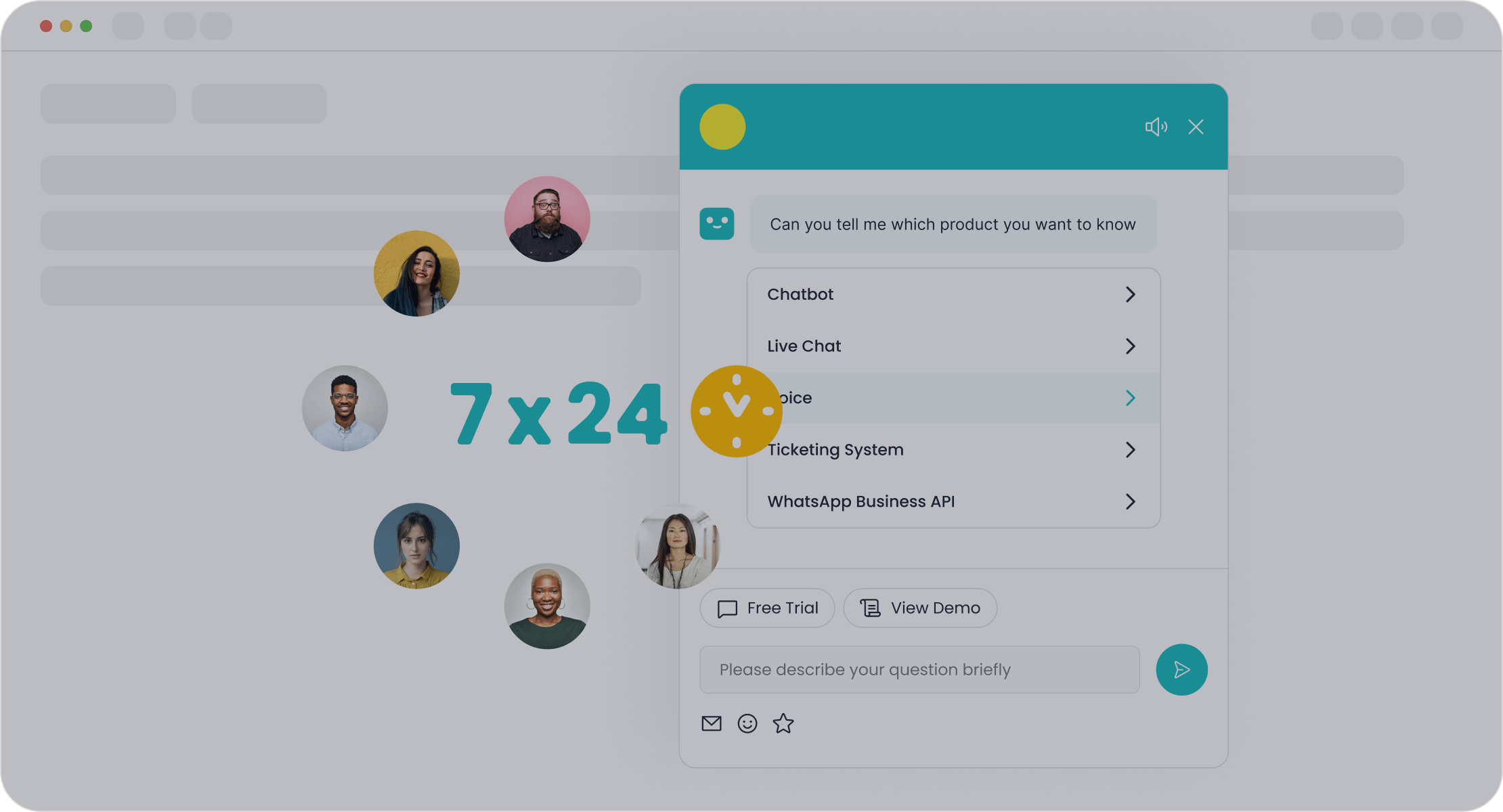
You face a new era of customer pain points in 2025. Over 50% of consumers leave a brand after a single negative experience. Personalization gaps, digital overload, and slow response times now drive customer churn. The table below shows why these issues matter:
| Statistic Description | Value |
|---|---|
| Consumers expecting unique understanding | 73% |
| Customers valuing immediate responses in customer service | 90% |
| Customers leaving after two poor experiences | 86% |
You need solutions that improve customer satisfaction and loyalty. Sobot AI and its product suite help you resolve common customer pain points examples across every channel.
Digital Overload
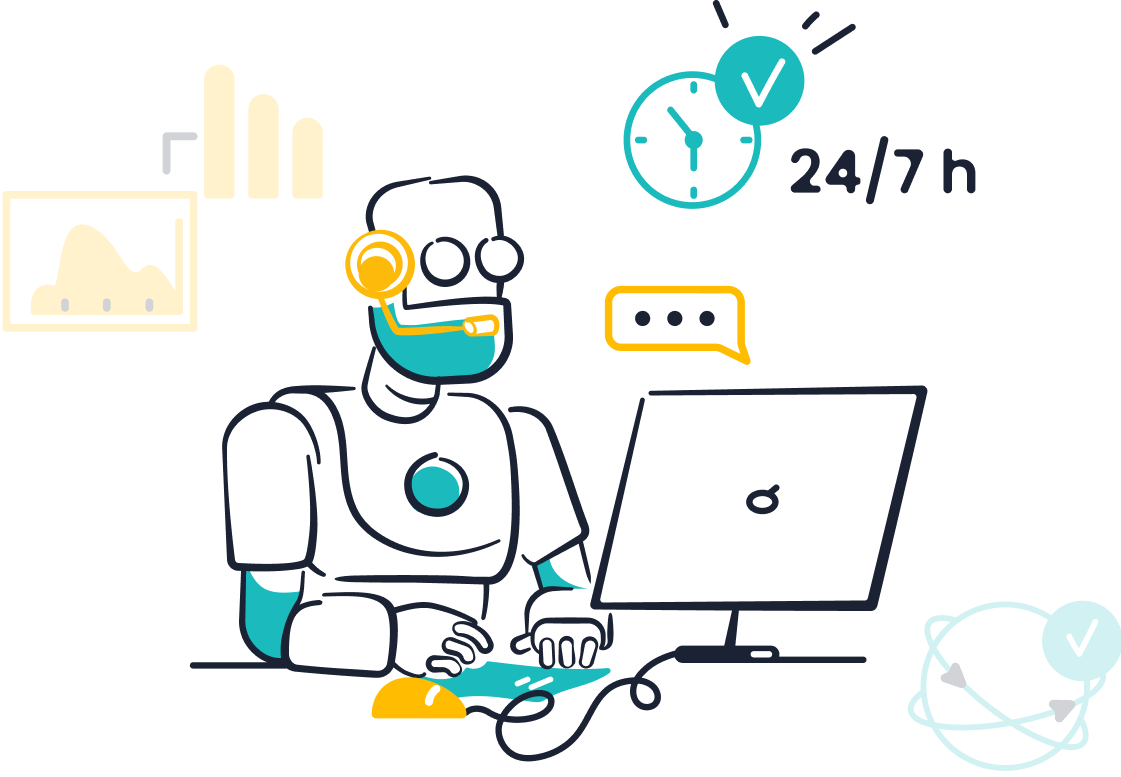
Omnichannel Challenges
You face more digital noise than ever before. In 2025, 74% of consumers feel overwhelmed by constant marketing messages. This digital overload leads to decision fatigue and lower customer satisfaction. Many customers struggle with fragmented communication across multiple platforms. When you contact customer service, you often repeat your issue on every channel. This wastes time and increases frustration.
- Fragmented channels cause longer wait times and inconsistent experiences.
- Customers see lower Customer Effort Scores (CES) and Net Promoter Scores (NPS).
- Companies lose revenue when customers abandon brands due to poor omnichannel experiences.
A recent study shows that 68% of customers leave brands because of inconsistent service across channels. Fragmented tools and siloed data make it hard for your team to deliver fast, accurate support. These tech pain points hurt both customer loyalty and business growth.
Streamlined Solutions
You can solve these customer pain points with a unified approach. Sobot’s omnichannel platform brings all your customer interactions into one workspace. This integration lets you manage chat, email, voice, and social media from a single dashboard. Your team sees the full customer journey, so you never ask customers to repeat themselves.
Sobot’s platform helps you reduce tech pain points and improve customer service quality. You boost efficiency and deliver seamless support.
The impact is clear. Companies like Nike and Nordstrom saw up to a 45% improvement in customer satisfaction and a 35% increase in digital sales after adopting omnichannel solutions. Industry-wide, omnichannel customers have a 30% higher lifetime value. Sobot’s all-in-one contact center helps you achieve these results by unifying your customer service channels and reducing the lack of tech talent needed to manage multiple tools.
| Company | Omnichannel Initiative | Key Metrics / Improvements |
|---|---|---|
| Nike | Consumer Direct Acceleration leveraging app data | 35% increase in digital sales; 3X increase in app engagement |
| Nordstrom | Shared inventory system across channels | 39% increase in inventory turnover; 45% improvement in customer satisfaction |
| Home Depot | Interconnected retail strategy with tech investment | 24% increase in digital sales; 40% increase in mobile app usage |
| RIMOWA | Omnichannel advertising campaign | 25% increase in unique reach; 17.4% increase in brand awareness |
You can learn more about Sobot’s omnichannel solutions at Sobot’s official website.
Personalization Gaps
AI-Driven Customization
You expect brands to know your preferences and deliver relevant experiences. Yet, many companies still struggle to meet these expectations. The gap between what you want and what you receive creates major customer pain points. In fact, 71% of consumers expect tailored content, but 67% feel frustrated when they do not get it. This frustration leads to lower loyalty and higher churn.
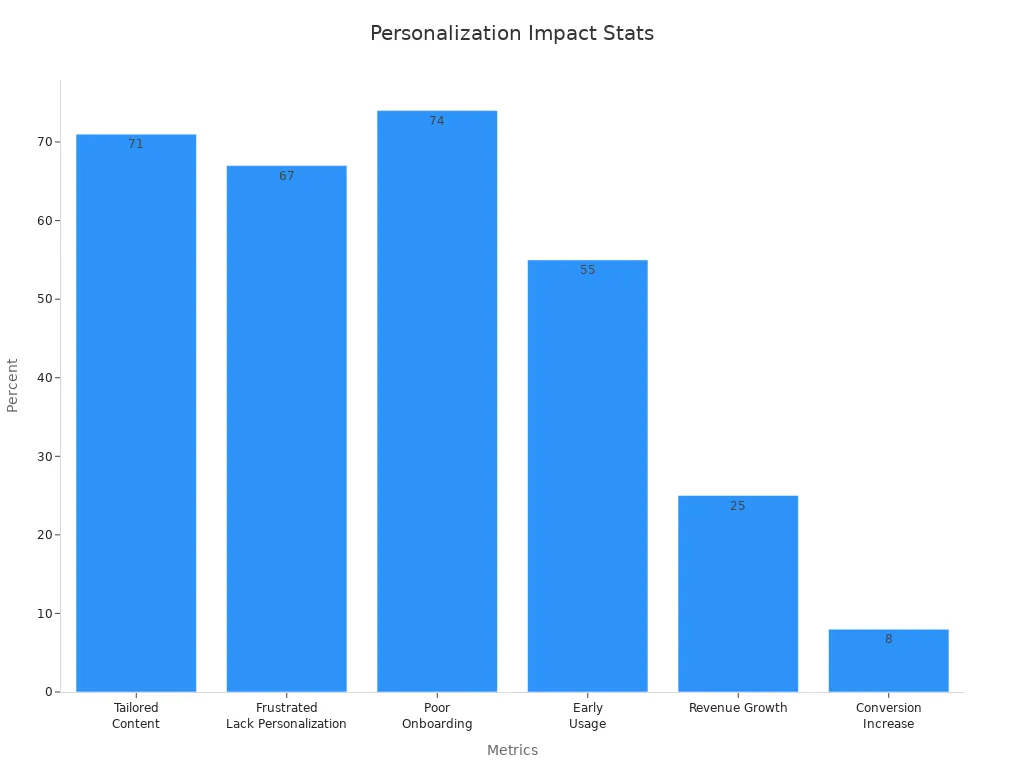

Sobot’s AI Chatbot helps you close these personalization gaps. The chatbot uses advanced AI to analyze your preferences and past interactions. It delivers personalized support across chat, email, voice, and social media. You get answers that match your needs, not generic responses. Sobot’s AI-driven customization builds trust and increases your satisfaction throughout the consumer journey.
AI-powered customer service does more than save time. It builds trust and delivers real value by meeting your expectations at every touchpoint.
Research shows that AI-driven personalization increases customer loyalty by 1.5 times and boosts conversion rates by 8%. Companies that focus on personalizing the consumer experience see up to 25% revenue growth. Sobot’s solutions help you achieve these results by making every interaction feel unique and relevant.
Customer Pain Points Examples
You may notice several customer pain points examples when companies fail to personalize your experience. These include:
- Needing to repeat your issue every time you contact customer service.
- Receiving irrelevant recommendations or generic responses.
- Waiting longer for help because agents lack information about your history.
A lack of tailored experiences often leads to lower Customer Satisfaction Scores (CSAT), higher Customer Effort Scores (CES), and more repeat calls. The table below highlights measurable customer pain points examples:
| Measurable Metric | Customer Issue Indicated by Metric |
|---|---|
| Increased repeat customer calls | Unresolved issues from non-personalized handling |
| Lower Customer Satisfaction Score (CSAT) | Unhappiness from generic service |
| Lower Net Promoter Score (NPS) | Less likely to recommend due to poor personalization |
| Higher Customer Effort Score (CES) | More effort needed to resolve issues |
| Longer First Response Time | Delays in receiving personalized attention |
| Lower First Contact Resolution Rate (FCR) | Issues not resolved on first contact |
| Increased Average Handling Time (AHT) | Longer calls from untailored service |
Sobot’s AI Chatbot addresses these customer pain points by providing instant, relevant answers and remembering your preferences. This approach improves the overall customer experience and reduces frustration at every stage of the consumer journey.
Slow Response Times
24/7 Support
You know how frustrating it feels to wait hours for a response when you need help. In today’s fast-paced world, slow response times have become a major pain point for every customer. When you reach out to a business, you expect immediate answers. Studies reveal that 90% of customers consider quick responses essential, and 75% are willing to pay more for excellent service. If you do not get timely support, your satisfaction drops, and you may switch to another brand.
| Metric / Statistic | Data Point | Explanation |
|---|---|---|
| Customers willing to pay extra for good service | 75% | Shows the value placed on quality support. |
| Customers considering immediate response important | 90% | Highlights the need for fast support. |
| Consumers likely to make repeat purchases with excellent service | 93% | Links service quality to loyalty. |
| Customers defining “immediate” as within 10 minutes | 60% | Sets the standard for response time. |
| Customers rating customer service as important for loyalty | 96% | Underlines the role of service in retention. |
You can see that 24/7 support is no longer optional. It builds trust and keeps your customers loyal. With round-the-clock service, you reduce ticket backlogs and ensure every customer feels valued. The following chart shows how 24/7 support boosts retention and service quality:
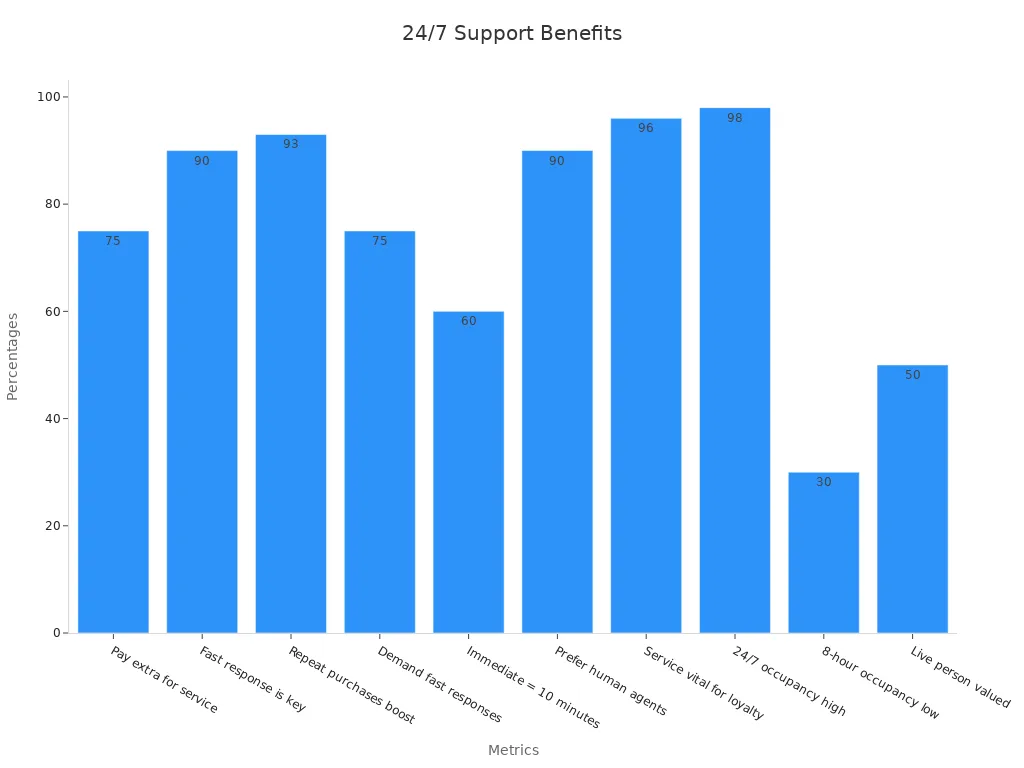
Automation with Sobot Chatbot
You can solve slow response times by using automation. Sobot’s AI Chatbot delivers instant answers to your customers at any hour. The chatbot handles routine questions, freeing your agents to focus on complex issues. This approach improves productivity and ensures no customer waits too long.
Here are some key performance metrics that show the impact of slow response times:
| Performance Metric | Impact on Customer Satisfaction and Retention |
|---|---|
| Customer Lifetime Value (CLV) | Drops with slow responses, reducing revenue. |
| Customer Satisfaction Score (CSAT) | Falls when customers wait too long. |
| Net Promoter Score (NPS) | Decreases as loyalty declines. |
| Average Response Time (ART) | Longer times increase frustration. |
| Customer Retention Rates | Decline as customers leave for faster service. |
Sobot’s chatbot operates 24/7, supports multiple languages, and integrates with your preferred channels. You improve your customer experience, boost agent efficiency, and keep satisfaction scores high. Companies using Sobot have seen up to a 70% increase in productivity and a 25% reduction in costs, as shown by Agilent’s success story. Learn more about Sobot’s chatbot at Sobot Chatbot.
Data Privacy Concerns
Trust and Transparency
You expect companies to protect your personal information. In 2025, data privacy stands as a top concern for every customer. Recent studies show that 94% of organizations report customers will not buy if they do not trust a company’s data security. Over 86% of the US population worries about how businesses handle their data. When you see news about data breaches or cybersecurity failures, your trust drops quickly.

You want companies to be open about how they collect, store, and use your data. Transparency builds trust and helps you feel in control. When a company explains its cybersecurity practices, you feel safer and more loyal. Clear communication about data security policies reduces your uncertainty and increases your confidence in the brand.
- Customers expect openness about data collection and usage.
- Transparency leads to higher satisfaction and loyalty.
- Open communication channels foster long-term relationships.
If a company fails to provide clear information, you may stop doing business with them. In fact, 71% of consumers say they would leave a brand after a privacy issue.
Secure Solutions
You need strong protection for your personal information. Companies must follow strict data security and cybersecurity standards to keep your data safe from breaches. Regulations like GDPR, CCPA, and SOC 2 require businesses to use encryption, access controls, and continuous monitoring. These frameworks help prevent breaches and protect customer information.
| Statistic Description | Percentage | Source |
|---|---|---|
| Organizations reporting increased customer loyalty and trust from data privacy investments | 80% | Cisco |
| Consumers more loyal to companies with strong security controls | 84% | Salesforce |
| Organizations reporting increased operational efficiency and innovation from privacy investments | 78% | Cisco |
Sobot takes data security and cybersecurity seriously. The platform uses advanced encryption, access management, and regular audits to protect your data. Sobot complies with global standards, including GDPR and ISO 27001, to ensure your information stays secure. With Sobot, you can trust that your customer data is handled with care and transparency. This commitment helps you build stronger relationships and reduces the risk of costly breaches.
Inconsistent Service Quality
Inconsistent service quality remains one of the most common customer pain points in 2025. You might notice that when you contact a company, the level of support changes depending on the channel, agent, or even the time of day. This inconsistency creates confusion and frustration, making it hard for you to trust the brand or the product. When you receive unclear communication or promises that go unmet, your expectations and experience do not match. These gaps can lead to negative customer feedback, lower loyalty, and a damaged reputation.
Unified Platforms
You can address tech pain points and product pain points by using a unified platform. Sobot’s all-in-one contact center brings every customer interaction—whether chat, email, voice, or social media—into a single workspace. This approach ensures that your team delivers the same high quality of service every time, no matter the channel. Research shows that companies with strong omnichannel strategies retain 89% of their customers, while those with weak strategies keep only 33% (Aberdeen Group). With Sobot, you gain visibility into key metrics like customer satisfaction, first response time, and resolution rates. This data helps you spot tech pain points and improve workflows, leading to better product quality and more consistent customer experiences.
| Metric Name | Description | Impact on Service Quality and Customer Experience |
|---|---|---|
| Customer Satisfaction (CSAT) | Measures how satisfied customers are with a specific interaction or overall service. | Lower CSAT scores indicate dissatisfaction often caused by inconsistent service. |
| Net Promoter Score (NPS) | Gauges customer loyalty and likelihood to recommend the brand. | Declining NPS can signal negative impact from inconsistent service quality. |
| First Contact Resolution Rate | Percentage of issues resolved in the first interaction. | Low rates suggest inefficiency and inconsistency in service delivery. |
Employee Training
You can further standardize service quality by investing in employee training. Well-trained staff deliver more reliable support, reducing product pain points and improving customer feedback. Companies with formal training programs report 218% higher income per employee, and productivity rises by 17%. In fact, 59% of employees say training improves their job performance. Sobot offers training resources and knowledge bases that help your team master the platform and deliver consistent, high-quality support. When your employees know how to use the product and handle customer issues, you see fewer mistakes and more positive feedback. This commitment to training ensures that every customer receives the same level of care, no matter who handles their request.
Sustainability Expectations
Eco-Friendly Operations
You see sustainability as a core value in modern business. Today, more customers expect brands to show real commitment to eco-friendly operations. Over half of global consumers say they will pay more for sustainable products and services. Nearly 70% research a brand’s sustainability claims before making a purchase. You want companies to go beyond greenwashing and take real action.
- 54% of consumers are willing to pay a premium for sustainable options.
- 64% rank sustainability as a top-three value driver in their choices.
- 46% have purchased at least one sustainable product or service in the past year.
Contact centers can meet these expectations by adopting eco-friendly practices. You can reduce energy use by switching to renewable sources and using energy-efficient equipment. Environmental audits help you find ways to cut energy consumption by up to 30%. Waste management, like reducing single-use plastics and recycling, lowers your environmental impact. Training your team and rewarding green actions builds a culture of sustainability. Companies like IKEA and Unilever have shown that these steps lead to real results, such as lower emissions and higher brand loyalty.
| Practice | Example/Impact |
|---|---|
| Renewable energy adoption | Google and Apple power operations with renewables |
| Energy-efficient appliances | EPA audits show up to 30% less energy use |
| Waste reduction | Circular economy cuts landfill waste |
| Employee engagement | Training boosts green initiative success |
| Green supply chains | Eco-friendly suppliers reduce total environmental impact |
Customer Pain Points
You notice when brands fail to meet your sustainability expectations. Unsustainable digital operations can lead to higher customer pain points and lower satisfaction. If a company uses outdated systems or wastes resources, you may see longer wait times and less efficient service. This can cause frustration and even drive you to switch brands.
| Metric | Description | Impact of Unsustainable Practices |
|---|---|---|
| Churn Rate | Customers leaving over time | High churn from poor service or inefficiency |
| Net Promoter Score (NPS) | Loyalty and likelihood to recommend | Low NPS from unhappy customers |
| Customer Satisfaction (CSAT) | Satisfaction with service | Low CSAT from friction or slow support |
| Customer Effort Score (CES) | Ease of resolving issues | High CES from inefficient digital processes |
| Average Resolution Time (ART) | Time to resolve issues | Longer ART leads to frustration and churn |
You want brands to use digital tools that support both efficiency and sustainability. Sobot’s cloud-based contact center helps you reduce your carbon footprint by minimizing hardware needs and optimizing resource use. By choosing solutions that align with your values, you help create a better future for everyone.
Accessibility Barriers
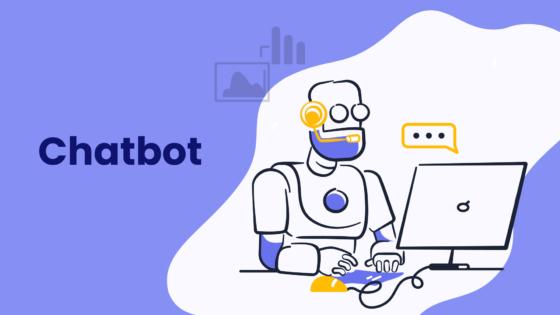
Inclusive Design
You face accessibility barriers when digital services do not consider your needs. Over 96% of top websites remain inaccessible, which means most online platforms fail to meet basic standards. This creates customer pain points for the 16% of the world’s population—almost 1.3 billion people—who live with disabilities. Many customers rely on features like screen readers, keyboard navigation, or adjustable text sizes. When these features are missing, you may struggle to complete simple tasks or access important information.
| Statistic | Description |
|---|---|
| Over 96% of top websites are inaccessible | Most popular sites do not meet accessibility standards. |
| 16% of the world’s population have disabilities | A large group faces digital barriers. |
| 51% of consumers willing to pay more for accessible services | Many value and seek out accessible options. |
| $13 trillion market opportunity | Businesses can unlock huge value by being inclusive. |
Inclusive design helps solve these customer pain points. Features like alternative text, closed captions, and adjustable fonts make digital platforms usable for everyone. When you see companies prioritize accessibility, you feel valued and included. This approach builds trust and strengthens your connection with the brand.
Support Solutions
You expect support that works for all customers, regardless of ability. Many people use accessibility settings—45% of iOS and 61% of Android users activate them. If a company ignores these needs, it risks legal action and loses customer trust. Digital accessibility also improves the experience for everyone, not just those with disabilities.
Sobot’s solutions help you overcome accessibility barriers. The Sobot AI Chatbot supports multiple languages and channels, making it easy for you to get help in your preferred way. The platform offers 24/7 self-service, which reduces transaction abandonment and boosts satisfaction. Research shows that 69% of consumers prefer chatbots for quick answers, and 88% expect online self-service options. Sobot’s unified workspace ensures that every customer receives consistent, accessible support, helping you resolve issues faster and with less effort.
Prioritizing accessibility not only meets legal requirements but also improves customer loyalty and brand reputation. You help create a more inclusive world when you choose solutions that work for everyone.
You face new customer challenges in 2025. Customers expect fast, personalized product support and secure data handling. You can boost customer satisfaction by using Sobot’s product suite. Sobot’s AI-driven product helps you collect feedback, improve product quality, and increase customer loyalty. You see higher customer satisfaction when you act on feedback and use product insights. Sobot’s product lets you track customer feedback, resolve product issues, and deliver better customer experiences. Start by reviewing your product workflows and gather feedback to drive product improvements.
FAQ
What are the most common customer pain points examples in 2025?
You often face digital overload, slow response times, personalization gaps, and data privacy concerns. These customer pain points examples lead to frustration and lower loyalty. Studies show 86% of customers leave after two poor experiences (source).
How does Sobot help solve customer pain points examples?
Sobot unifies all channels into one platform. You get instant, personalized support from the AI Chatbot. This approach reduces customer pain points examples like long wait times and repeated questions. Sobot’s solutions improve satisfaction and boost efficiency for your team.
Why is addressing customer pain points examples important for business growth?
You keep customers loyal when you resolve customer pain points examples quickly. Businesses that address these issues see higher Net Promoter Scores and more repeat sales. Research shows companies with strong customer service grow revenue up to 25% faster (source).
Can Sobot’s AI Chatbot handle customer pain points examples in multiple languages?
Yes. Sobot’s AI Chatbot supports multiple languages. You receive help in your preferred language, which removes communication barriers. This feature addresses customer pain points examples for global businesses and improves the overall customer experience.
What metrics show improvement after solving customer pain points examples?
You see higher Customer Satisfaction Scores (CSAT), lower Average Handling Time (AHT), and increased First Contact Resolution rates. Sobot’s platform tracks these metrics, helping you measure progress as you resolve customer pain points examples and deliver better service.
See Also
Effective Strategies To Enhance Live Chat Customer Experience
How To Successfully Deploy Omnichannel Contact Center Systems
Best Contact Center Technologies Evaluated For 2024
